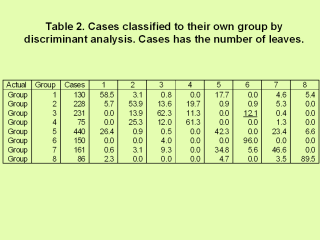| front |1 |2 |3 |4 |5 |6 |7 |8 |9 |10 |11 |12 |13 |14 |15 |16 |17 |18 |19 |20 |21 |22 |23 |24 |25 |26 |27 |28 |29 |30 |31 |review |
 |
The results of discriminant analysis follow in
Table 2. The overall percent of classified to its own proper group was 58.0
%. The torreyana trees of Hermosillo (Group 1) resemble those of Navajoa (5)
and the intermediates (7) of Guaymas. The intermediates in Hermosillo (2)
are nondescript somewhat like Mazatán (3) & Novillo (4) trees. Mazatán shows
affinity to its neighbors and even to Tiny. The 3 choices can be: 1) Tiny is
introgressng to its northeast, 2) conditions inducing Tiny are affecting
Matazán, and 3) these constraints are combined. Novillo (4), coming from an
excellent water supply with 67 m LR shows affinity to its logical neighbors.
Stable Najavoa has torreyana affinity. Tiny (6 trees of Group 6) of Guaymas
has very slight resemblence to Mazatán being distinct otherwise. The
long-rachis old-styled torreyanas (125 mm LR) of Guaymas are fairly distinct
and only resemble their intermediates with Tiny, Navajoans and the
torreyanas of Hermosillo. The amount of fluctuation in LR per tree could be important, because natural selection is operating on it to favor a short rachis. The means range from 21-127 LR. The coefficient of variation in percent (CV %) for all 56 trees is 14.6 ± 6.7 CV%, ranging from 2.6-34.5 CV%. Race Tiny has a maximum of 19.6 CV%. The 3 long rachis trees in Guaymas have 123, 125 & 127 LR with 22.4, 33.6 & 34.5 CV%. Hermosillo, Navajoa & Guaymas have the same overall variance. When all 56 trees are accounted there are 88 2 PR and 1413 1 PR leaves. The 2 PR leaves are smaller as 64 % LL, 65 % LR, 112 % PL & 67 % LP. A similar result occurs with any individual mesquite tree thus the 2 PR dose could have epistatic action. Guaymas has 5 types of trees. The velutine influence is demonstrated by the presence of 2 PR. |